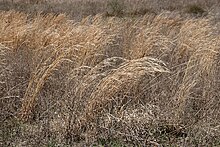Prairie
Prairie refers to an area of land of low topographic relief that historically supported grasses and herbs, with few trees, and having generally a mesic (moderate or temperate) climate.
In North America
Lands typically referred to as "prairie" tend to be in North America. The term encompassed much of the area referred to as the Great Plains (constituted by most or all of the states of North Dakota, South Dakota, Nebraska, Kansas, Oklahoma, Texas, Colorado, Wyoming and Montana), and sizeable parts of the states of Indiana, Illinois, Iowa, Missouri, Wisconsin and Minnesota. In Canada, prairie occupied vast areas of Manitoba, Saskatchewan, and Alberta. French explorers called these areas prairie, from the French word for "meadow". Sometimes, in the United States and Canada, a distinction is made between the shortgrass vegetation of the High Plains west of the 100th meridian and the midgrass and tallgrass vegetation to the east (from central Texas to southern Manitoba). When this distinction is made, it is common to limit the word "prairie" to the midgrass and tallgrass area. Almost all of this area has been converted into farmland in the last two hundred years (the shortgrass area can be considered to be a steppe).
The natural incidents
In spite of long recurrent droughts and occasional torrential rains, the grasslands of the Great Plains are not subject to great soil erosion. The deep, interconnected root systems of prairie grasses firmly hold the soil in place and prevent run-off. These deep roots also help prairie plants to reach water in even the driest conditions. The prairie evolved to survive in extreme conditions and suffers less damage from dry conditions than the farm crops which have replaced many former prairies.
The Fire
Fire is an important part of prairie ecology; natural and human-induced fires were common in historic prairie areas, rejuvenating the herbaceous species, and top killing trees and brush. Grazing by animals such as the American Bison and Prairie dogs also helped maintain the original prairie ecology. Small areas of prairies also exist in eastern North America, and it is possible that these were created by Native Americans by periodic burning. One such area was along the southeastern shore of Lake Erie in what is now Pennsylvania and New York; another was between Seneca Lake and Cayuga Lake in present New York.

Preserved prairies
Significant preserved areas of prairie include:
- Midewin National Tallgrass Prairie, in Will County, Illinois
- Neal Smith Wildlife Refuge, Iowa
- Konza Prairie, Manhattan, Kansas
- Tallgrass Prairie National Preserve, Kansas
- Nine-Mile Prairie, Nebraska
- Zumwalt Prairie, Wallowa County, Oregon
- Richard Bong State Recreation Area, in Kenosha County, Wisconsin
- Hoosier Prairie, in Lake County, Indiana
- Jacobsburg Environmental Education Center, Pennsylvania
Virgin prairies
Virgin prairie refers to prairie land that has never been plowed. Small virgin prairies exist in the American Midwestern states and in Canada. Restored prairie has been reseeded after plowing or other disturbance.
In the World
Prairies are considered part of the temperate grasslands, savannas, and shrublands biome by ecologists, based on similar temperate climates, moderate rainfall, and grasses, herbs, and shrubs, rather than trees, as the dominant vegetation type. Other temperate grasslands regions include the Pampas of Argentina, and the steppes of Russia and Ukraine.
See also
- Buffalo Commons
- Coastal plain
- Coastal prairie
- Field
- Flooded grasslands and savannas
- Flood-meadow
- Grassland
- Meadow
- Pasture
- Plain
- Prairie madness
- Rangeland
- Savanna
- Steppe
- Water-meadow
- Wet meadow
- Veld
